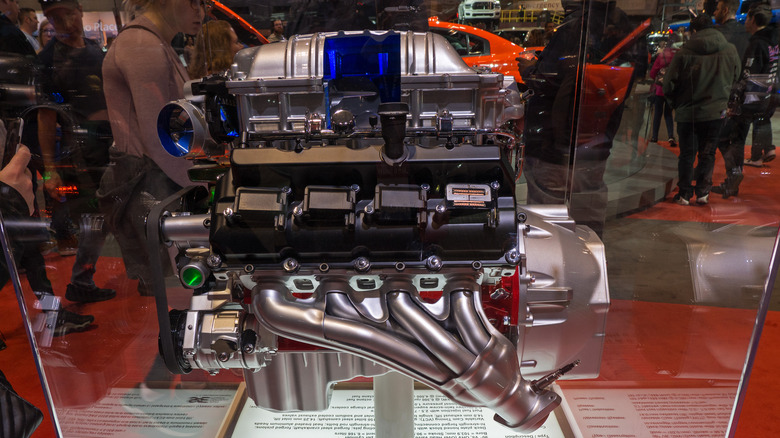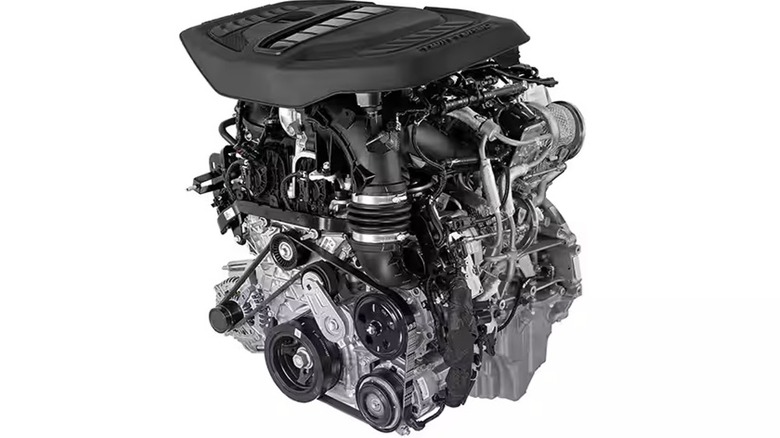Why Is Dodge Discontinuing The HEMI Engine?
The hemispherical (HEMI) engine has been an automotive staple since its first generation starting in 1951. Used in classic trucks and legendary muscle cars up until 1971, the HEMI was revived in the early 2000s. Ram trucks started coming equipped with the 5.7-liter HEMI, then enthusiasts received the massive 6.2-liter HEMI V8 D170, that powered the Dodge Hellcat. When every major HEMI engine is ranked, from least to most horsepower, the top spot features one with 1500 horses.
With so many memorable iterations, why would Stellantis (one of a small group of companies who own all the top car brands in the world, including Dodge) decide to shelve an iconic engine? First, the government tightened emission standards again, which require auto manufacturers to quickly adapt their engines or face fines, costing automakers substantial amounts of money. Secondly, the Ram 1500 has a new twin-turbo Hurricane I-6 engine, which surpasses the 5.7-liter HEMI in performance. Unfortunately, the new Hurricane engine doesn't offer the same aggressive engine notes produced by the HEMI V8.
Emissions standards versus the HEMI
This isn't the first time tightening emissions restrictions ran the Hemi engine away from the automobile industry. The oil crises in the early '70s saw the big block V8s in popular muscle cars drastically reduce output, as automakers tried to lower emissions and improve fuel economy. The technology hadn't yet developed a way to produce more efficient engine power, so previously impressive V8s were intentionally hampered to meet new environmental qualifications. Drivers started looking for more fuel-economy-friendly vehicles with smaller engines, and the HEMI exited production in 1971.
In 2003, the HEMI engine was revived, much to the delight of horsepower enthusiasts the world over. But a big problem developed in 2016. Stellantis was required to pay $128 million in fines for the 2016 through 2017-year HEMI engines that didn't meet the National Highway Traffic Safety Administration's (NHTSA) new standards. The 2018 through 2019 HEMI's also failed to meet regulations, costing Stellantis another $235 million in fines.
The Hurricane is powerful and can hit emissions targets
Since Stellantis has had trouble maintaining the HEMI engine through increasingly more stringent regulations, they have opted to replace it with a smaller, turbocharged Hurricane. Turbocharging transforms engine performance and produces more output with less cubic inches. At only 3.0-liter, the standard turbocharged Hurricane inline-six generates 420 horsepower and 469-pound feet of torque, with the High-output version producing 540 horsepower and 521-pound feet of torque. Compare that to the 5.7-liter HEMI, which offers 395 horsepower and 410-pound feet of torque. So, while the new Ram 1500 will lack the HEMI name, it will still outperform previous models.
Reworking or specially tuning an existing engine to meet new regulations is both resource and time intensive. One outlet remarked, "Why spend the engineering budget trying to tune a naturally aspirated engine to meet performance and emissions targets when you know you can ace the test and still make that headline horsepower number by bolting on a turbocharger instead?" When you factor in the fines accrued so far and the cost to spend more time retuning the latest HEMI, Dodge opted for a replacement with the Hurricane. But the HEMI has returned before, who is to say it won't make another appearance in the future?


